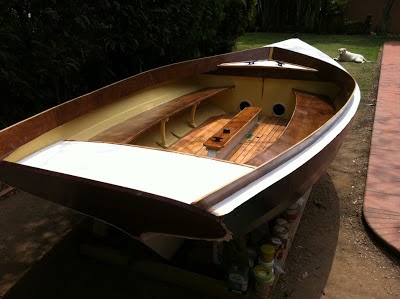My son John asks "what are you doing"? I say "scarfing the garboard". He says "I only understand the word 'the' in that sentence"....
Scarfing
 |
| Noel ripping the boards to one foot widths |
Well, the
scarfing worked out easier than expected. We set up a
scarfing jig that I made (
instructions here), cut all the 3/8" plywood boards into 4 x one-foot wide lengths each , then ran the
 |
| Boards glued and clamped |
circular saw along the edges with the scarfing jig, as per the link above, wet the edges with epoxy, then thickened the epoxy, put plenty on and clamped them with dry-wall screws and one-foot bits of Douglas fir. Worked a treat and all boards are now scarfed into 16-foot lengths, one foot wide. All seem, touch wood..., very solid. I didn't wax the screws, but they all came out fine. (if they ever don't, put a hot soldering iron on them for a minute to heat up and try again).
 |
| Noel lines up the board on scarfing jig |
 |
| The scarfing jig |
 |
Clamped with Fir
and dry-wall screws |
That's not the way the scarf joints are done in
John Brooks' book, but I reckon it's probably easier. All boards were scarfed in one afternoon. John uses the method of putting them all on top of each other set back 2 1/2", and planing along them. I haven't tried that way so it's not fair of me to say my method is easier, though with the scarfing jig we did get very even and consistent cuts, that meshed well and it was all very quick. All boards now piled up in my study.
Spiling
Then for the
Spiling of the first board: the Garboard.
For this, again I didn't follow John's book which uses a spiling batten and compass. Instead I used one-foot wide cardboard about 1/8" thick, joined together to the length of the Garboard, and ran a line around it, trimmed to the final shape of the Garboard, then used this pattern direct onto the plywood board. Seemed to work ok. I'm planning on this method for all the other boards. This way, I hope, any mistakes will be on the cardboard, which can easily be ditched and start again. [On reflection, maybe there's some trap here; I guess I'll find out in due course...]
Fitting the Garboard
 |
| Arlene works on dry fitting the Garboard |
Next, getting the Garboard on the Keelson and to the Transom.... Dry fitting first, before copying the final board to a second one, and then glueing both.
Oh boy, that was some work, and I've just come in from it. Drenched with sweat...
First, I tried the alternative method in John Brooks' Plans, which is to have no notches in the Transom, but instead to cut some tapering grooves lengthways in the Garboard at the transom end, about 3/4" apart and about a foot along, to "relieve the stiffness" as John says, the idea being that you can then bend it to the reverse curve of the Transom.
Nice idea, but I couldn't get it to work.
Although I cut the grooves several times, each time a bit deeper, I couldn't get the board to bend to the required line, so I decided to put a notch in the Transom, after all.
Dave says on his blog,
here, that he found it difficult to fit the Garboard to the notch which he had pre-cut. He says that if were to do it over, he would cut the notches after the Transom is installed on the Jig. Well, I can now say that cutting the notches
after is also tricky, because you have the 14' mold in the way, and cutting only with a hand saw, in the limited space between the Transom and the Mold is quite tricky too. The only other alternative might have been a jig-saw, but I didn't really trust that and mistakes would have been more serious, I think
Now I have a combined method: the plank fitting into the notch, but with a bit of space still, which I'm hoping will come down flush with screws (using the pre-cut "relieving grooves"), when I get back to it.
I say "get back to it", cause I've come in, driven inside to the air-conditioning by the extreme heat and humidity. All that faffing around in temperatures that my Weather Channel App tells me is about 105 degrees (41C) and humid, I came in dripping head to toe.... Shower and change. I feel I've had a work out at the gym....























































